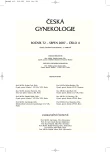How Can the Haematopoietic Stem Cells from the Umbilical Cord Blood be De-Differentiated in vitro? Our First Results Using the Co-Cultivation Systems
Jak dediferencovat hematopoetické kmenové buňky z umbilikální krve in vitro? Naše první výsledky s použitím kokultivačních systémů
Cíl studie:
Cílem naší práce bylo za pomoci kokultivace dediferencovat lidské hematopoetické kmenové buňky (HKB), které jsme izolovali z pupečníkové krve.
Typ studie:
Prospektivní experimentální studie.
Název a sídlo pracoviště:
Laboratoře Institutu reprodukční medicíny a endokrinologie, Plzeň.
Metodika:
HKB byly kokultivovány s myšími embryonálními kmenovými buňkami (mEKB), a to jak za přítomnosti podpůrných buněk, tak bez nich. HKB byly po kokultivaci analyzovány jednak pomocí průtokového cytometru na přítomnost hematopoetických markerů (CD34, CD45, CD133) a jednak pomocí imunohistochemie na přítomnost markerů dediferenciace (SSEA-4, Tra-1-60, Tra-1-81).
Výsledky:
Ani jedna forma kokultivace s mEKB k dediferenciaci HKB nevedla. Jedinou změnou ve fenotypu HKB buněk byl pokles intenzity hematopoetických markerů.
Závěr:
Domníváme se, že k dediferenciaci nedošlo ze dvou důvodů: nebyl umožněn přímý kontakt buněk a kokultivovány byly buňky dvou různých živočišných druhů. Naším cílem je pokračovat v pokusech dediferencovat dospělé kmenové buňky pomocí kokultivačních systémů za použití buněk stejného živočišného druhu a přímého kontaktu buněk.
Klíčová slova:
hematopoetické kmenové buňky (HKB), myší embryonální kmenové buňky (mEKB), pupečníková krev, průtoková cytometrie, imunohistochemie
Authors:
P. Uher 1,2; R. Hűttelová 1
; M. Králíčková 1,2; Z. Novotný 2; Z. Rokyta 2; P. Vanderzwalmen 3
Authors‘ workplace:
Institut reprodukční medicíny a endokrinologie, Plzeň, vedoucí lékař MUDr. P. Uher
1; Gynekologicko-porodnická klinika LF UK a FN, Plzeň, přednosta doc. MUDr. Z. Rokyta, CSc.
2; Centre Hospitalier Inter Regional Cavell (CHIREC), Braine l`ąlleud, Brusel, Belgie.
3
Published in:
Ceska Gynekol 2007; 72(4): 280-283
Category:
Original Article
Overview
Objective:
Aim of this study was to de-differentiate the haematopoietic stem cells (HSCs) that originated from the umbilical cord blood. One of the ways to do it is to use a co-cultivation system.
Design:
Prospective experimental study.
Setting:
Laboratory study - Institute of reproductive medicine and endocrinology, Pilsen.
Methods:
HSCs were co-cultivated with mouse embryonic stem cells (mESC) with and without feeder cells. After co-cultivation HSCs were analyzed using flow-cytometry for presence of haematopoietic markers (CD34, CD45, CD133) and using immunohistochemistry for presence of embryonic stem cell markers (SSEA-4, Tra-1-60, Tra-1-81).
Results:
No de-differentiation was detectable in any our experiment, only the intensity of the HSC cell markers decreased.
Conclusion:
We suppose that there were two major reasons for the experiment failure: there was no direct cell to cell contact and there was a mixture of cell types that originated from two different species. To reach our goal of in vitro de-differentiation we will need to change our strategy towards a pure human culture system without any animal additives and with cell to cell contact.
Key words:
haematopoietic stem cells (HSCs), mouse embryonic stem cells (mESC), umbilical cord blood (UCB), flow cytometry (FACS), immunohistochemistry
Labels
Paediatric gynaecology Gynaecology and obstetrics Reproduction medicineArticle was published in
Czech Gynaecology

2007 Issue 4
Most read in this issue
- Maternal Position at the Delivery and Perineal Trauma
- Prediction of Intrauterine Growth Retardation Using the Integrated Test Markers
- The Science-Meter Indicators (Citation index, Impact factor, Hirsch-index) and the Evaluation of the Scientific Activity in Medicine
- Occult Anal Sphincter Tear – Up-to-date Knowledge
